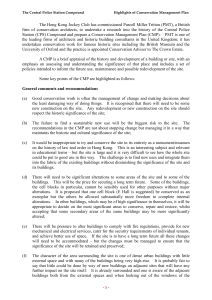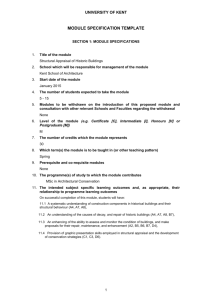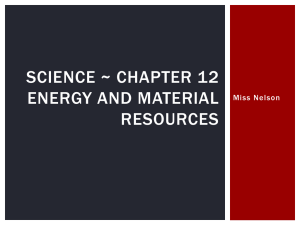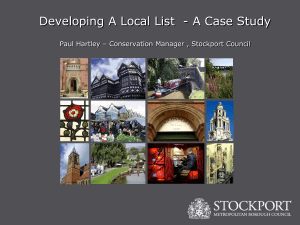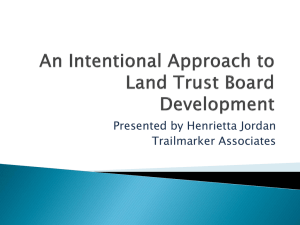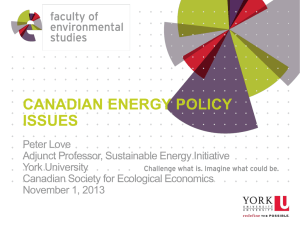maintenance plans and conservation management
advertisement
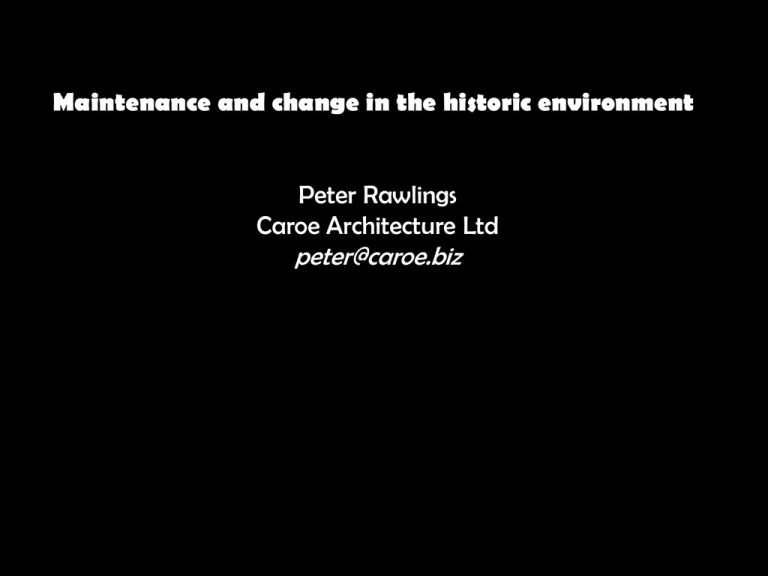
Maintenance and change in the historic environment Peter Rawlings Caroe Architecture Ltd peter@caroe.biz • who I am • Buildings and life cycles • Principles of conservation and maintenanceeegimes • Common features of historic buildings that need maintenance • Some common issues for historic buildings • Statutory constraints • How to keep on top of things – maintenance plans and conservation management OUTLINE OF TALK This talk • Architect and Director of Caroe Architecture Ltd • worked with new and old buildings over a period of 20 years, including houses, churches, range of institutional buildings • with Inskip & Jenkins Architects – Battersea Power Station, Somerset House • with vHH Architects – Corfield Court, Cambridge, No 1 Smithery, also new buildings – schools & health centres • with Caroe Architecture Ltd – range of scales from St Paul’s Cathedral to the Warren House, Kimbolton. PETER RAWLINGS Who I am – an architect’s perspective • Structure: floors, walls, roof structure – generally solid load bearing, but can be framed: 50 to 100 year (in some cases almost indefinite if properly maintained) • Roof covering (and wall coverings – building envelope): 50 years for a flat roof, perhaps 100 years for a well detailed lead roof cf 15 years for a felt roof • Heating, plumbing electrical installations: 15 years • Finishes and internal decorations, fittings and furnishings: perhaps 5 years – depends on wear and tear LIFE CYCLES Buildings as an assembly of different elements PRINCIPLES put Protection in the place of Restoration, William Morris to stave off decay by daily care, to prop a SPAB Manifesto perilous wall or mend a leaky roof by such 1877: means as are obviously meant for support or covering, and show no pretence of other art, and otherwise to resist all tampering with either the fabric or ornament of the building as it stands; if it has become inconvenient for its present use, to raise another building rather than alter or enlarge the old one; in fine to treat our ancient buildings as monuments of a bygone art, created by bygone manners, that modern art cannot meddle with without destroying. Burra Charter 1979 & 1999 International Council on Monuments and Sites Article 17. Preservation Preservation is appropriate where the existing fabric or its condition constitutes evidence of cultural significance, or where insufficient evidence is available to allow other conservation processes to be carried out. Article 18. Restoration and reconstruction Restoration and reconstruction should reveal culturally significant aspects of the place. Article 19. Restoration Restoration is appropriate only if there is sufficient evidence of an earlier state of the fabric. Article 20. Reconstruction 20.1 Reconstruction is appropriate only where a place is incomplete through damage or alteration, and only where there is sufficient evidence to reproduce an earlier state of the fabric. In rare cases, reconstruction may also be appropriate as part of a use or practice that retains the cultural significance of the place. 20.2 Reconstruction should be identifiable on close inspection or through additional interpretation. PRINCIPLES Article 16. Maintenance Maintenance is fundamental to conservation and should be undertaken where fabric is of cultural significance and its maintenance is necessary to retain that cultural significance. Burra Charter 1979 & 1999 Article 22. New work 22.1 New work such as additions to the place may be acceptable where it does not distort or obscure the cultural significance of the place, or detract from its interpretation and appreciation. 22.2 New work should be readily identifiable as such. Article 23. Conserving use Continuing, modifying or reinstating a significant use may be appropriate and preferred forms of conservation. PRINCIPLES Article 21. Adaptation 21.1 Adaptation is acceptable only where the adaptation has minimal impact on the cultural significance of the place. 21.2 Adaptation should involve minimal change to significant fabric, achieved only after considering alternatives. • maintenance before repair • repair rather than replace • honest but sympathetic repair • take care not to speculate • keep the water out • allow the building to breath • use appropriate materials • considered and planned approach • think detail in context • avoid loss of character PRINCIPLES General maintenance Principles General design principles PRINCIPLES • maintain current use where appropriate & possible • light & deft touch • reversibility & timescale (life cycles) • reuse of existing openings for circulation and services • removal of fabric on an informed basis • allowing the best of the building to speak (singing together) GOOD MAINTENANCE Regular maintenance 1. Rainwater goods 2. Roofs 3. Junctions: Holes, splits 4. Walls: Check mortar joints and render coatings (use lime) 5. Ground levels: 6. Ventilation: 7. Gullies and drains 8. Plants 9. Services: heating systems and plumbing, electrics 10. Safety first TOOLS & HELP Some tools and help available • Dampness and infestation investigation • Asbestos investigation • Dendrology • Archaeological investigation • Paint sampling – stratigraphy • Thermal imaging & air tightness • Material analysis • Conservator trials • Conservation accreditation Difficult questions: ISSUES • Should we repair or replace? (life cycles) • Where does the authenticity of a historic building lie? (fabric, appearance) • What is acceptable change for a building? (Chatham. St Mary’s) • If change is not acceptable should we leave it to rot? • What compromises are acceptable to users? • What improved environmental performance is achievable in old buildings? • What is affordable? Depends on time frame, funding streams etc. • Should we retain facades? • Where is the role for creativity? Difficult questions: ISSUES • Should we repair or replace? (life cycles) Difficult questions: ISSUES • What is acceptable change for a building? Difficult questions: ISSUES Some common challenges for historic buildings to be addressed in the maintenance period ISSUES access • equality act / building regulations Part M • strategic planning of access (with access consultant) • sensitive interventions Some common challenges for historic buildings to be addressed in the maintenance period ISSUES environmental performance • environmental agenda (building regulation part L) • improve thermal performance • reduce air leakage • more efficient heating systems • low carbon systems Some common challenges for historic buildings to be addressed in the maintenance period • careful fire engineering • low impact products • can achieve acoustic upgrade at same time ISSUES fire upgrade work Some common challenges for historic buildings to be addressed in the maintenance period • coatings to protect •against fire ISSUES fire upgrade work • repair that involves change of material or detail may need listed building approval and/or SAM consent • it is a criminal offence to carry out unauthorised work • the whole building is listed! (even the modern ugly bits!) • fixtures and fittings are listed if attached to the building • for C of E churches there is faculty jurisdiction LISTINGS Statutory constraints related to maintenance • listed buildings – grade 1, 2* and 2 • scheduled ancient monuments • registered parks • conservation areas • buildings of local interest • ask your conservation officer • check the English Heritage website conservation management plans maintenance plans (including financial planning) • Continuous maintenance • Capital maintenance • Capital enhancement • Poor maintenance results in higher capital cost CONSERVATION PLANS How to keep on top of things – maintenance plans and conservation management • SPAB website •HELM website •Churchcare website • Old House Handbook Roger Hunt & Marianne Suhr • National Trust Manual of Housekeeping • EH Conservation Principles – policies and guidance • Conservation of Historic Buildings – Bernard Fielden • Ask your Local Authority conservation officer • RIBA conservation architect register • RICS building conservation register FURTHER READING Where can I find our more? (some sources)

